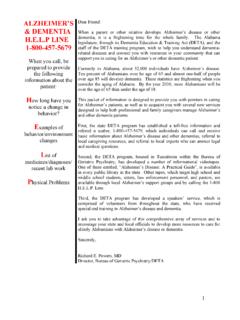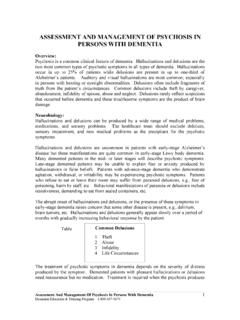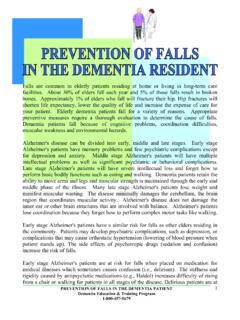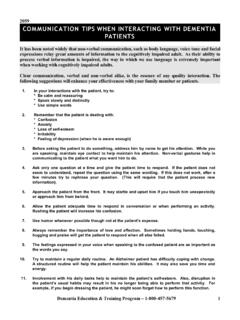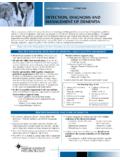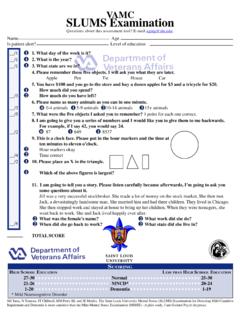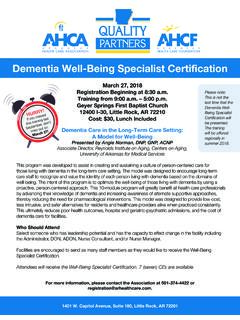Transcription of CLINICAL ASSESSMENT OF DEMENTIA - Alzbrain
1 CLINICAL ASSESSMENT OF : The Neuroanatomy of CognitionAssessment of DEMENTIA requires a set of skills and knowledge that span several CLINICAL domains. The clinician should be familiar with normal aging, brain anatomy, brain pathology that produces DEMENTIA and common disorders that mimic DEMENTIA . Clinicians should combine basic CLINICAL evaluation skills with other disease-specific assessments to provide accurate high-quality DEMENTIA assessments. The symptoms of DEMENTIA re divided into cognitive, functional, and psychiatric. Cognitive symptoms include intellectual deficits such as amnesia or aphasia. Functional impairments include inability to perform common activities of daily living (ADLs) while psychiatric manifestations include behavioral and psychological symptoms of DEMENTIA (BPSD).The proper ASSESSMENT of DEMENTIA requires that the clinician understand the four or five most common diseases that produce cognitive loss in the elderly as well as the neuroanatomy of cognition, four or five medical problems that mimic DEMENTIA , and basic ASSESSMENT strategies that capture essential information.
2 The average DEMENTIA ASSESSMENT requires approximately one hour; however, this process can be broken into several segments. A careful examination is accurate in 90% of cases when performed by a knowledgeable clinician. The value of laboratory studies or sophisticated brain imaging is ancillary rather than diagnostic. Recent advances in the understanding and treatment of DEMENTIA underscore the importance of adequate ASSESSMENT . New treatments for Alzheimer s disease are most effective when employed in the earliest stages of the disorder. Scientists are exploring the boundary between age-related memory impairment and DEMENTIA for ways to better distinguish those individuals who will later develop significant cognitive impairment. The pharmaceutical industry is developing over 70 medications for specific types of DEMENTIA . Clinicians will be tasked to distinguish common types of DEMENTIA for appropriate therapeutic interventions.
3 Functional Neuroanatomy of Language and MemorySpecific cognitive functions are assigned discreet brain regions to process this information. For example, the left anterior frontal lobe, , Broca s area, is assigned the task of motor speech. Dysfunction of this cortical segment may produce expressive aphasia. The proper function of expressive speech depends on three factors: 1) the presence of intact circuits within the inferior frontal cortex, 2) the appropriate balance of ascending cholinergic and catecholaminergic projections that facilitate frontal lobe transmission, and 3) the integrity of subcortical loops that process information through the basal ganglia, thalamus, and other structures to maintain frontal lobe function and tone. A second model is sensory processing. The accurate interpretation of spoken word requires proper function of sensory organs that provide raw sensory input to primary auditory processing centers in the transverse temporal gyrus of the temporal lobe.
4 The encoded electrical signal is then transferred to the association cortex in the superior temporal gyrus for interpretation and final integration of the auditory message with other sensory data in the multimodal association cortex of the temporal pole. These circuits depend upon ascending catecholiminergic projections for proper synchronization and function. CLINICAL ASSESSMENT OF DEMENTIA1A third basic function is memory that includes recent and remote data. The human brain is flooded with sensory information, , telephone conversation, events on the drive to work, etc. The human brain, like the home PC, has a work station and a hard disc. The workstation is an analogous to short-term recall, while hard disc is analogous to long-term memory. Long-term memories are stored over broad neural networks, while short-term memory is processed through the human hippocampus.
5 The neurobiology of long-term memory is poorly understood in humans. Short-term recall, , memories lasting 5-15 minutes, operates through human hippocampus. The hippocampus receives a piece of auditory information from the auditory association cortex which projects to a very specific destination along the length of the hippocampus, , a tubular structure in the mesial temporal lobe. The data is transmitted into cortex adjacent to the hippocampal formation, an area termed the entorhinal cortex where it is relayed into a series of circuits within the hippocampal structure and back to the temporal lobe for temporary storage. The proper function of this circuit is dependant upon intact neurons in the temporal lobe as well as the hippocampus and intact catecholaminergic projections that facilitate memory. The hippocampus contains a wide range of receptors including NMDA, , excitotoxic, steroid, cholinergic, adrenergic, and others.
6 This diversity of receptors explains how many drugs and injuries can produce memory problems. For example, hippocampal neurons are quite sensitive to hypoxia and hypoglycemia, and severe CLINICAL occurrences can produce memory ScreeningThe mini mental status examination (MMSE) is the basic screening instrument for intellectual function in persons over the age of 65. This 30 point inventory samples a wide range of intellectual functions. One MMSE item requires the recall of three words after five minutes. This simple task actually samples multiple cortical circuits because the individual must first hear the three words, and then understand those words. The examinee must commit those words to short-term memory and then have the expressive ability to repeat those words after five minutes. This simple task requires: 1) proper sensory function, 2) proper interpretation of the words, 3) registration of the information, 4) retrieval from memory, and 5) speaking the words back to the is distinct from memory.
7 Registration indicates that the person is capable of getting the three words into the workstation via a sensory port, while memory implies that the three words were loaded onto the workstation and retained for five or ten minutes. The mini mental status examination tests both registration and short-term recall. Registration is when the person is given the three words and asked to repeat them back. Memory is when the person is asked five or ten minutes later whether they can remember the three after they are engaged in other intellectual tasks. Damage at any point in the sensory, memory, or expressive language centers can produce dysfunction. Either damage of intrinsic neurons or disruption of crucial neuromodulators, , acetylcholine, within the circuit can produce dysfunction. The screening instrument will not identify the level of disruption but rather dysfunction of the circuit.
8 Sophisticated neuropsychological testing may detect the precise level of dysfunction that produces specific symptoms, , failure to remember three words at five ASSESSMENT OF DEMENTIA2 Information must pass through the hippocampus to enter memory. Damage to intrinsic hippocampal neurons, diminished amounts of essential neuromodulators, , norepinephrine or serotonin, as well as excessive stimulation or blockade of intrinsic hippocampal receptors, , alcohol-induced NMDA receptor dysfunction, may produce memory dysfunction. The failure to remember three items that are properly registered may result from: 1) depression that lowers hippocampal serotonin and norepinephrine, 2) delirium that disrupts other hippocampal transmitter systems, 3) hypoxia that over-stimulates NMDA receptor and damages intrinsic hippocampal circuits, as well as 4) any degenerative disease such as Alzheimer s or diffuse Lewy body that damages hippocampal or parahippocampal neurons.
9 Disorders that damage multiple components to the system probably impacts memory greater than disorders that damage isolated units. Similar complex circuits exist for almost every type of cognitive processing and damage to these circuits produce core symptoms of DEMENTIA , including amnesia, aphasia, apraxia, and agnosia. Elements of CLINICAL AssessmentThe CLINICAL ASSESSMENT of DEMENTIA begins with a careful detailed CLINICAL history to determine the precise features of intellectual loss. DEMENTIA produces three categories of symptoms: 1) cognitive or intellectual, 2) functional, and 3) psychiatric or behavioral that predicts the level of functional disability. The sequence of symptom development and the timing of CLINICAL features are helpful but not diagnostic. Many older persons fail to recognize memory impairment as a problem and attribute their memory dysfunction to old age.
10 Most affected older individuals with mild DEMENTIA recognize their loss of intellectual functions in the early stages. Clinicians should inquire about specific behavioral problems, , forgetting to shut off the stove, cooking from cards rather than from memory, forgetting important conversation, etc., to assess short-term recall problems. Clinicians should assess the duration of symptoms by inquiring as to when the person last felt like their old self . The longitudinal history is essential to determine other medical conditions that might be contributory to cognitive loss, , memory problems for about two years coinciding with a stroke or heart bypass surgery, etc. Abrupt onset memory problems are unusual in persons with Alzheimer s disease and other possible causes, , delirium and depression, should be considered when significant cognitive decline occurs over a period of weeks to several months.


